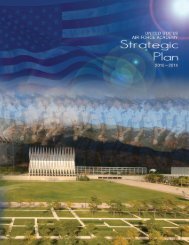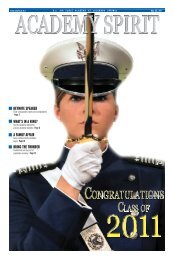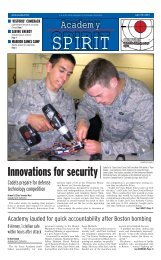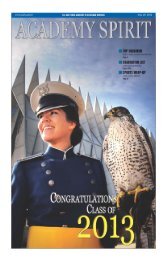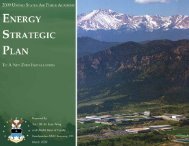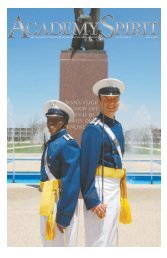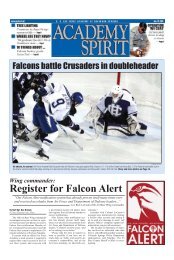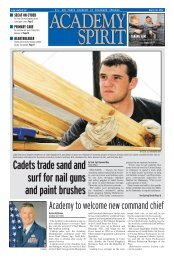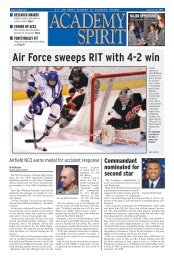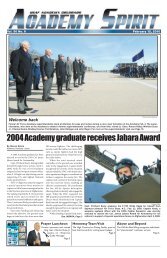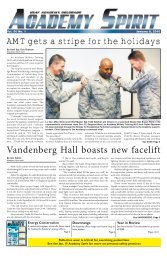2008-2009 Catalog - United States Air Force Academy
2008-2009 Catalog - United States Air Force Academy
2008-2009 Catalog - United States Air Force Academy
You also want an ePaper? Increase the reach of your titles
YUMPU automatically turns print PDFs into web optimized ePapers that Google loves.
friction and heat transfer. Foundations in engineering problem solving.<br />
Aero Engr 315. Fundamentals of Aeronautics. Introduction to aircraft design, fluid mechanics, airfoil and wing<br />
aerodynamics, steady and accelerated aircraft performance, and stability and control. Interdisciplinary design synthesis,<br />
analysis and decision-making (including economic, political, and other non-technical considerations) of an aircraft to meet a<br />
contemporary requirement.<br />
Aero Engr 315Z. Fundamentals of Aeronautics – French language section. Section taught in French; available for<br />
students qualified for Aero Engr 315 and having successfully completed or validated French 321; counts as a course for the<br />
French Language Minor and for a major’s foreign language requirement. Requires DFF approval.<br />
Aero Engr 341. Aeronautical Fluid Dynamics. Fluid properties, the basic equations of motion: the continuity equation,<br />
conservation of linear momentum, and conservation of energy (both the differential and the integral forms). Use of the<br />
integral momentum equation to experimentally determine the drag acting on a cylinder in a low-speed stream; spread-sheet<br />
computation of unsteady Poiseuille flow; spread-sheet computation of a steady, laminar boundary-layer; turbulent boundarylayer<br />
experiment. Stream functions. Potential functions.<br />
Aero Engr 342. Computational Aerodynamics. This course covers the theory and application of modern computational<br />
tools used to predict fluid flows around basic and complex geometries. The course is intended to give the student the necessary<br />
knowledge to choose the relevant computational tool and perform independent computational analysis of moderately complex<br />
geometries. The course will cover grid generation, computational fluid dynamic (CFD) solvers, and post-processing using stateof-the-art<br />
tools, as well as computational potential methods such as panel codes or vortex lattice codes. The course is projectoriented<br />
and explores the important concepts of temporal and spatial resolution, stability and convergence, and flow-field<br />
analysis.<br />
Aero Engr 351. <strong>Air</strong>craft Performance and Static Stability. <strong>Air</strong>craft force, moment and response definition in various<br />
coordinate systems. Takeoff and landing, cruise, climbs, turns and other accelerated performance by both analytic and<br />
numerical methods. Static stability and control and related aircraft design considerations. Design project.<br />
Aero Engr 352. <strong>Air</strong>craft Dynamic Stability and Control. <strong>Air</strong>craft equations of motion. Examination of aircraft dynamic<br />
modes based on both limited and full degree of freedom models utilizing analytical and numerical methods. <strong>Air</strong>craft design<br />
considerations. Determination and evaluation of aircraft flying qualities against military specifications. Application of control<br />
system theory to the design of aircraft stability augmentation systems and autopilots. Control system design project.<br />
Aero Engr 361. Propulsion I. Introduction to Brayton and jet engine cycles. Application of aero-thermodynamics to aircraft<br />
jet engines and major engine components. Overview of the design, performance, and applications of turboprops/shafts,<br />
turbofans, turbojets, ramjets, and scramjets. Focus on preliminary cycle analysis of aircraft gas turbine engines to include<br />
mission analysis, parametric cycle analysis, and engine performance analysis. Introduction to performance and operating<br />
principles of solid and liquid rocket engines. Lab. Design project.<br />
Aero Engr 436. Aeroelasticity. Aeroelastic phenomena of an aircraft in flight. Dynamic pressure, Mach and angle of<br />
attack effects on the bending and twisting of aircraft components. Aeroelastic equations and coefficients related to flight<br />
characteristics such as flutter and divergence.<br />
Aero Engr 442. Aerodynamics. Analytical and numerical solution techniques applied to incompressible, compressible,<br />
transonic, and supersonic flight regimes over airfoils, wings, and bodies. Introduction to hypersonic aerodynamics. Techniques<br />
include those historically used in incompressible flow up to and including state-of-the-art supersonic solutions using high speed<br />
computers.<br />
Aero Engr 446. Introduction to Hypersonics. Analysis of heat transfer and high temperature effects on hypersonic<br />
vehicles. Application to reentry and transatmospheric vehicles.<br />
Aero Engr 447. Advanced Applied Aerodynamics. Advanced topics in steady and unsteady aerodynamics in all speed<br />
ranges are considered for study by analytical, experimental and computational methods.<br />
Aero Engr 456. Flight Test Techniques. Fundamental flight test methods for defining performance and flying qualities<br />
characteristics of fixed wing aircraft. Patterned after the Flight Test Engineer’s Course at the <strong>Air</strong> <strong>Force</strong> Test Pilot School.<br />
Students fly in designated aircraft to obtain flight test data.<br />
54 <strong>United</strong> <strong>States</strong> <strong>Air</strong> <strong>Force</strong> <strong>Academy</strong> <strong>Catalog</strong>



